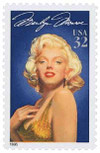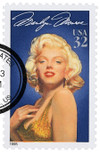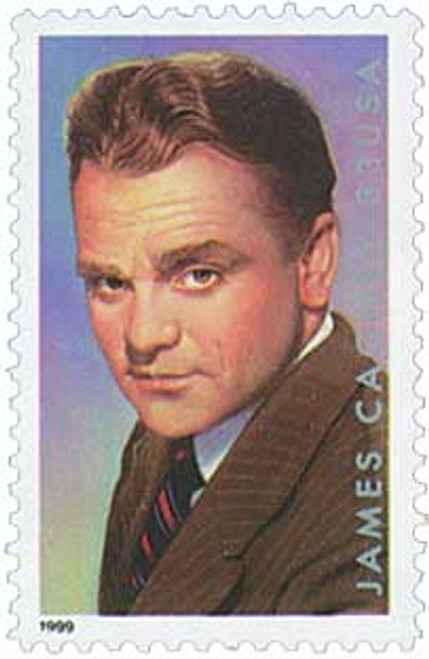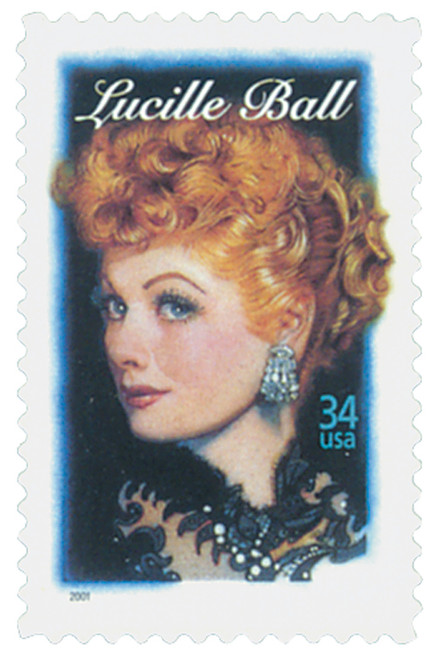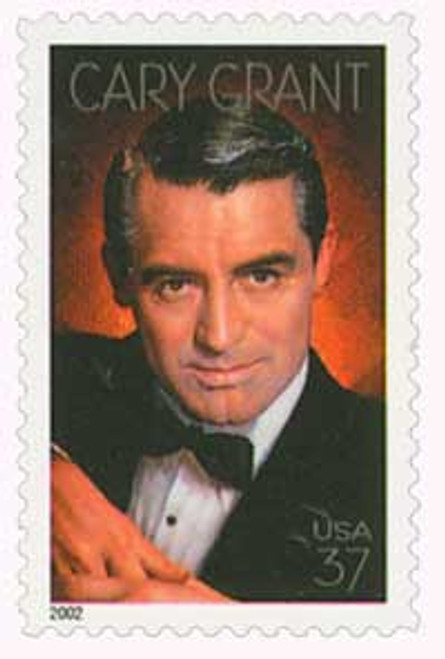
# 2967 - 1995 32c Legends of Hollywood: Marilyn Monroe
U.S. #2967
1995 32¢ Marilyn Monroe
Legends of Hollywood
- First stamp in Legends of Hollywood Series
- #1 selling postage stamp of 1995; #7 on list of most popular commemoratives issued up to that time
- First US stamp with a trademark (™) designation
Stamp Category: Commemorative
Series: Legends of Hollywood
Value: 32¢, rate for first-class mail
First Day of Issue: June 1, 1995
First Day City: Universal City, California; stamps also available nationwide same day
Quantity Issued: 400,000,000
Printed by: Stamp Venturers
Printing Method: Photogravure
Format: Panes of 20 in sheets of 120
Perforations: 11.1; star-shaped perforations in each corner
Why the stamp was issued: The stamp was issued on Marilyn Monroe’s 69th birthday. It also marked the start of the long-running Legends of Hollywood Series.
About the stamp design: The USPS tasked nine different artists with creating possible portraits for the stamp. Some produced more than one, but the portrait that wowed them was a quick sketch produced by Michael Deas. His portrait was based on a 1953 promotional photo of Monroe for Gentlemen Prefer Blondes. He added a hand to the image to give it more motion, elegance, and to capture a bit of her vulnerability. The USPS worked with Monroe’s estate, which required an inscription on the bottom of the full sheets. Additionally, if they wanted to include her signature, they had to include a trademark symbol, a US postal first, though it was printed very small and close in color to the background, so it was essentially invisible to the naked eye. The same Monroe portrait was used for the sheet’s selvage, though it was cropped higher and her hand removed.
As part if its massive marketing campaign, the USPS also offered a large variety of other products – uncut press sheets, panes signed by the stamp designer, a Stamp Folio, a commemorative panel, and a first-day program with a pop-up model of Monroe.
Special design details: The stamp had star-shaped perforations in each corner. There were also nine different tagging varieties. This came about because the tagging was only applied over the stamp images, so the outer stamps on each pane don’t have tagging in some areas around the perforations.
First Day City: This stamp was issued at Universal Studios in Hollywood, California, which is one of the world’s largest film and TV studios. Several celebrities who worked with Monroe attended the ceremony. There were also ceremonies held in other cities, as the stamp was made available nationwide the same day.
Unusual fact about this stamp: There have been complete and partly imperforate sheets discovered, as well as some with incomplete corner star perforations.
About the Legends of Hollywood Series: Following the success of the 1993 Elvis Presley stamp, postal officials wanted to do another stamp featuring a charismatic star that could have similar appeal to stamp collectors and fans alike. They chose Marilyn Monroe and would launch a large campaign to promote the stamp saying, “She’s as gorgeous on a tiny stamp as she was on the giant screen.” While the stamp proved popular, it wasn’t without its critics, who opposed her appearance on stamp. Some claimed it “trivializes our history” and was inappropriate. But the supporters far outweighed the detractors, and stamp marked the first in a popular and long-running series.
The Legends of Hollywood Series continued in 1996 with a stamp honoring James Dean. That stamp and future issues followed the same format as the Marilyn stamp, with a painting of each star and their signature on the stamp as well as selvage art and a brief write-up about their career. While the Marilyn stamp sheet used an enlarged version of the stamp image, the rest of the sheets in the series would use different portraits on the stamp and in the selvage. Over the years, several of the stamps were issued on the stars’ birthdays, and often in Los Angeles or other cities relevant to each star. By the time the series ended in 2016, it had honored 20 stars.
History the stamp represents: Marilyn Monroe was born Norma Jeane Dougherty on June 1, 1926, in Los Angeles, California. Dubbed the “Blonde Bombshell,” she was one of the most popular actresses of the 1950s and early 1960s.
Norma Jeane had an unsettled childhood and bounced around orphanages and foster homes. She married James Dougherty just days after her 16th birthday, in 1942. James served in the Merchant Marine during World War II, and Norma Jeane took a job at the Radioplane Munitions Factory. Her job was to spray fire retardant on airplane parts and inspect parachutes. However, one day in 1945, an Army photographer named David Conover took her picture for a series of “women war workers” for Yank magazine. Conover was assigned to the job by US Air Force Captain Ronald Reagan.
After that, Norma Jeane went to work for Blue Book Modeling Agency and became a successful model, appearing on numerous magazine covers. It was during this time that she dyed her hair blonde. She tried nine different shades of blonde before settling on platinum. A year after her first modeling pictures, she was given a screen test by 20th Century Fox.
“It’s Jean Harlow all over again!” said studio executive Ben Lyon at the screen test. That was no coincidence – when Norma Jeane was a little girl, one of her guardians, Grace McKee, was fascinated with Jean Harlow (a famous Hollywood beauty). Grace and young Norma Jeane frequently went to the movies and Norma Jeane’s hair was curled to resemble Harlow’s. As a model, she studied photos of Harlow.
Lyon offered her a standard six-month contract of $125 a week. It was at this time that she changed her name to “Marilyn Monroe.” Lyon told her she reminded him of actress Marilyn Miller, so she took the first name and added her grandmother’s name “Monroe.”
Monroe’s first film, in which she had a small part, was The Shocking Miss Pilgrim in 1947. Monroe continued to work steadily, but did not become a star until 1953’s Niagara skyrocketed her career. Gentlemen Prefer Blondes and How to Marry a Millionaire closely followed it, both also released in 1953. After Gentlemen Prefer Blondes, Monroe was invited to sign her name and put her hand and footprints in the concrete in front of Grauman’s Chinese Theater on Hollywood Boulevard. At the age of 27, Monroe was voted the Best New Actress of 1953 by Photoplay magazine.
By 1955, Monroe grew tired of her kooky blonde image and was ready to begin a serious acting career. She moved to New York to learn from Lee Strasberg. In 1956, she started her own motion picture company, which produced Bus Stop and The Prince and the Showgirl. In 1959, Monroe was awarded a Golden Globe for Best Actress in a Comedy for her performance in Some Like It Hot. In 1962, she received a Golden Globe for Female World Film Favorite.
For about a decade, Monroe was a top-billed actress, with her films grossing $200 million. But she struggled with depression and addiction for several years and ultimately died from an overdose on August 5, 1962, at the age of just 36. Monroe completed thirty movies during her lifetime, leaving Something’s Got to Give unfinished.
Long after her death, Monroe is still respected and revered as one of America’s great Hollywood legends. A 1999 American Film Institute list ranked her at number six on their list of the greatest female screen legends from the Golden Age of Hollywood. Additionally, the Smithsonian Institution included her on their list of the 100 Most Significant Americans of All Time.
U.S. #2967
1995 32¢ Marilyn Monroe
Legends of Hollywood
- First stamp in Legends of Hollywood Series
- #1 selling postage stamp of 1995; #7 on list of most popular commemoratives issued up to that time
- First US stamp with a trademark (™) designation
Stamp Category: Commemorative
Series: Legends of Hollywood
Value: 32¢, rate for first-class mail
First Day of Issue: June 1, 1995
First Day City: Universal City, California; stamps also available nationwide same day
Quantity Issued: 400,000,000
Printed by: Stamp Venturers
Printing Method: Photogravure
Format: Panes of 20 in sheets of 120
Perforations: 11.1; star-shaped perforations in each corner
Why the stamp was issued: The stamp was issued on Marilyn Monroe’s 69th birthday. It also marked the start of the long-running Legends of Hollywood Series.
About the stamp design: The USPS tasked nine different artists with creating possible portraits for the stamp. Some produced more than one, but the portrait that wowed them was a quick sketch produced by Michael Deas. His portrait was based on a 1953 promotional photo of Monroe for Gentlemen Prefer Blondes. He added a hand to the image to give it more motion, elegance, and to capture a bit of her vulnerability. The USPS worked with Monroe’s estate, which required an inscription on the bottom of the full sheets. Additionally, if they wanted to include her signature, they had to include a trademark symbol, a US postal first, though it was printed very small and close in color to the background, so it was essentially invisible to the naked eye. The same Monroe portrait was used for the sheet’s selvage, though it was cropped higher and her hand removed.
As part if its massive marketing campaign, the USPS also offered a large variety of other products – uncut press sheets, panes signed by the stamp designer, a Stamp Folio, a commemorative panel, and a first-day program with a pop-up model of Monroe.
Special design details: The stamp had star-shaped perforations in each corner. There were also nine different tagging varieties. This came about because the tagging was only applied over the stamp images, so the outer stamps on each pane don’t have tagging in some areas around the perforations.
First Day City: This stamp was issued at Universal Studios in Hollywood, California, which is one of the world’s largest film and TV studios. Several celebrities who worked with Monroe attended the ceremony. There were also ceremonies held in other cities, as the stamp was made available nationwide the same day.
Unusual fact about this stamp: There have been complete and partly imperforate sheets discovered, as well as some with incomplete corner star perforations.
About the Legends of Hollywood Series: Following the success of the 1993 Elvis Presley stamp, postal officials wanted to do another stamp featuring a charismatic star that could have similar appeal to stamp collectors and fans alike. They chose Marilyn Monroe and would launch a large campaign to promote the stamp saying, “She’s as gorgeous on a tiny stamp as she was on the giant screen.” While the stamp proved popular, it wasn’t without its critics, who opposed her appearance on stamp. Some claimed it “trivializes our history” and was inappropriate. But the supporters far outweighed the detractors, and stamp marked the first in a popular and long-running series.
The Legends of Hollywood Series continued in 1996 with a stamp honoring James Dean. That stamp and future issues followed the same format as the Marilyn stamp, with a painting of each star and their signature on the stamp as well as selvage art and a brief write-up about their career. While the Marilyn stamp sheet used an enlarged version of the stamp image, the rest of the sheets in the series would use different portraits on the stamp and in the selvage. Over the years, several of the stamps were issued on the stars’ birthdays, and often in Los Angeles or other cities relevant to each star. By the time the series ended in 2016, it had honored 20 stars.
History the stamp represents: Marilyn Monroe was born Norma Jeane Dougherty on June 1, 1926, in Los Angeles, California. Dubbed the “Blonde Bombshell,” she was one of the most popular actresses of the 1950s and early 1960s.
Norma Jeane had an unsettled childhood and bounced around orphanages and foster homes. She married James Dougherty just days after her 16th birthday, in 1942. James served in the Merchant Marine during World War II, and Norma Jeane took a job at the Radioplane Munitions Factory. Her job was to spray fire retardant on airplane parts and inspect parachutes. However, one day in 1945, an Army photographer named David Conover took her picture for a series of “women war workers” for Yank magazine. Conover was assigned to the job by US Air Force Captain Ronald Reagan.
After that, Norma Jeane went to work for Blue Book Modeling Agency and became a successful model, appearing on numerous magazine covers. It was during this time that she dyed her hair blonde. She tried nine different shades of blonde before settling on platinum. A year after her first modeling pictures, she was given a screen test by 20th Century Fox.
“It’s Jean Harlow all over again!” said studio executive Ben Lyon at the screen test. That was no coincidence – when Norma Jeane was a little girl, one of her guardians, Grace McKee, was fascinated with Jean Harlow (a famous Hollywood beauty). Grace and young Norma Jeane frequently went to the movies and Norma Jeane’s hair was curled to resemble Harlow’s. As a model, she studied photos of Harlow.
Lyon offered her a standard six-month contract of $125 a week. It was at this time that she changed her name to “Marilyn Monroe.” Lyon told her she reminded him of actress Marilyn Miller, so she took the first name and added her grandmother’s name “Monroe.”
Monroe’s first film, in which she had a small part, was The Shocking Miss Pilgrim in 1947. Monroe continued to work steadily, but did not become a star until 1953’s Niagara skyrocketed her career. Gentlemen Prefer Blondes and How to Marry a Millionaire closely followed it, both also released in 1953. After Gentlemen Prefer Blondes, Monroe was invited to sign her name and put her hand and footprints in the concrete in front of Grauman’s Chinese Theater on Hollywood Boulevard. At the age of 27, Monroe was voted the Best New Actress of 1953 by Photoplay magazine.
By 1955, Monroe grew tired of her kooky blonde image and was ready to begin a serious acting career. She moved to New York to learn from Lee Strasberg. In 1956, she started her own motion picture company, which produced Bus Stop and The Prince and the Showgirl. In 1959, Monroe was awarded a Golden Globe for Best Actress in a Comedy for her performance in Some Like It Hot. In 1962, she received a Golden Globe for Female World Film Favorite.
For about a decade, Monroe was a top-billed actress, with her films grossing $200 million. But she struggled with depression and addiction for several years and ultimately died from an overdose on August 5, 1962, at the age of just 36. Monroe completed thirty movies during her lifetime, leaving Something’s Got to Give unfinished.
Long after her death, Monroe is still respected and revered as one of America’s great Hollywood legends. A 1999 American Film Institute list ranked her at number six on their list of the greatest female screen legends from the Golden Age of Hollywood. Additionally, the Smithsonian Institution included her on their list of the 100 Most Significant Americans of All Time.






